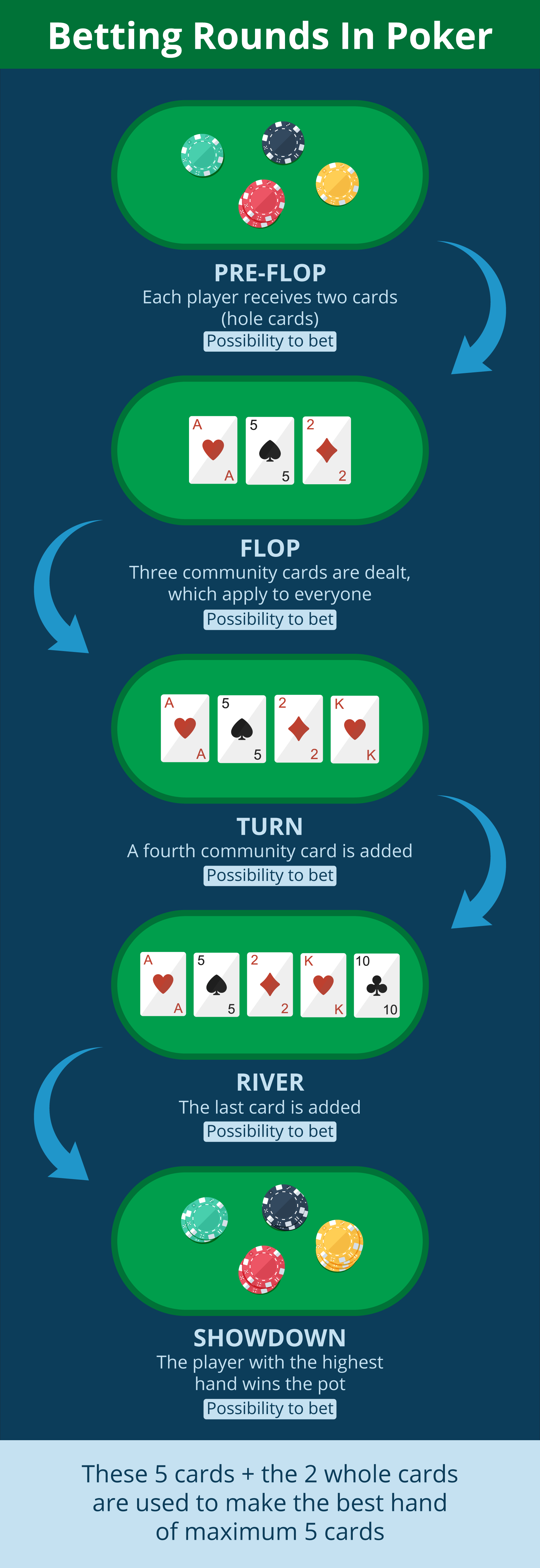Poker Rules, Bets, Odds, and Payouts
Your guide to better pokerPoker is a specialised game that requires a little strategising, a bit of guesswork and a dash of luck. Like all card games, poker can be as complicated or as simple as you’d like it to be. However, if you want to be in the running for the prize pot, grasping the basic poker rules is a must.
Play Poker at Some of Our Top Online Casinos in NZ
Master Poker rules
Poker is a global favourite and has spawned many variations over the years, broadening its reach and giving it wider appeal. Each variant utilizes the same basic rules of poker but adds a unique spin to the game. Before you hit the tables, let us school you in basic poker know-how including rules, bets and what is a poker odds calculator.
The objective
The objective in poker is to win the pot, which consists of all players’ bets for that round. When you win you get poker chips from the live dealer, which are then deposited as real money into your online casino account.
You can win this by having the highest-scoring hand or betting an amount that no other player matches. When you win the round you earn poker chips that are then translated into money.
Poker hands ranking
The table below illustrates how poker hands rank from highest to lowest.
| Poker hand | What it is |
|---|---|
| Royal Flush | A, K, Q, J and 10 of the same suit |
| Straight Flush | Five sequential poker cards of the same suit |
| Four of a Kind | Four poker cards of the same value, e.g. 10s, or 6s |
| Full House | Three poker cards of the same value, and another pair of equal value, e.g. J, J, J, 5, 5 |
| Flush | A hand with all five poker cards of the same suit |
| Straight | Five poker cards of different suits, but sequential numbers: 5, 6, 7, 8, 9 |
| Three of a Kind | Three poker cards of equal value |
| Two pair | Two pairs of poker cards |
| Pair | Two poker cards of equal value |
| High Card | The highest card in your hand if you don’t have any of the above configurations. |
Pre-flop, Flop, Turn, River, Showdown
Pre-flop, turn, flop, river, and showdown refer to actions at the start of each round after the dealer deals your two hole cards.
- Pre-flop – Before the flop, where you are forced to make your first important decision depending on all of the variables involved with the hand.
- Flop – After the players bet on the hole cards, the dealer discards the top card from the deck and places three community cards face-up on the playing surface. This is called the flop.
- Turn – The dealer discards another card from the top of the deck and places a fourth community card face-up on the surface. This is the turn.
- River – The river is the fifth community card and, together with each person’s hole cards, makes up the seven available cards that you can build a hand from.
- Showdown – A situation when, if more than one player remains after the last betting round, remaining players expose and compare their hands to determine the winner or winners.

Dealer button
In traditional poker, the role of dealer rotates around the table. Players use a marker to indicate the dealer for the round. With the advent of online poker, the dealer has become a centralized non-playing player who deals each round, so the task doesn’t fall to the individual players.
Online poker still uses the dealer button to indicate the nominal dealer who gets the last action on the round. This allows each player to take advantage of their table position. After each round, the button moves one place clockwise.
Big and small blinds
The blind refers to a compulsory bet at the start of a round unique to two table positions. The blind is a set value per table. The player to the left of the dealer button is called the small blind, and the player two spaces left of the button is the big blind. The small blind bets half the value of the big blind, and the game commences once those two mandatory bets are in.
No limit, pot limit and limit – Explained
Different poker games have different betting limits. You can join a table that suits your style of play and your bankroll.
At a no-limit poker table, you can raise by or bet any amount up to, but not exceeding, the size of your stack. A pot limit means that you can stake any amount up to the size of the pot. As the pot increases over rounds, the limit also increases. In fixed limit poker, you can only bet, raise or call by a preset amount.
Rule variations
Even a globally popular game like poker is subject to occasional Poker rules variations. While these don’t change the game’s objective, they may determine your strategy.
- Wild cards – If a card is declared wild, it can substitute for any other card to make a winning hand.
- Twist round – In a twist round, you can buy a card from the deck by adding money to the pot.
- Lowball – Some poker variants implement the lowball rule whereby the person with the lowest hand wins the pot.
Texas Hold-Em is the most widely-played poker variant worldwide. However, the most reputable online casinos in New Zealand have a range of variants that you can play. These include 7-Card Stud, Five-Card Draw, Jacks or Better, Caribbean Stud and Pai Gow Poker.
Types of bets in Poker
The key to your poker enjoyment and success is understanding the types of bets. Depending on your poker strategy, you may favour one action over another.
For example, if your strategy is to bluff your opponents into thinking that you have a stronger hand than you do, you might raise rather than call. Your table position can also dictate the strategy that you employ. The more comfortable you are with the rules of poker and bet types, the more you can incorporate strategic play into your game.
A poker game revolves around betting, and when your turn comes around, you can take one of several actions. Which one you take depends on factors like your table position, the poker pot odds, possible hands and your bankroll.
Call in Poker
Here, you match the current poker stake with the same value. By calling, you commit to staying in the game until your turn comes around again.
Raise in Poker
If you choose to raise, you increase the size of the existing bet. To do this, you must first match the existing bet before raising the poker stake to the desired amount.
Fold in Poker
Folding is a good option if you can’t make a significant hand with your cards and haven’t mastered a bluffing strategy. You forfeit your cards and stake when you fold and take no further part in the round.
Poker “All in”
Going all-in means committing your whole stack to the bet to stay in the game even if you don’t have sufficient chips to call the existing bet. Any bets placed after your turn goes into a side pot from which you‘re exempt should you win. You can also go all-in if you have an unbeatable hand, but this is a risky move.
Poker odds and payouts
Poker odds indicate the likelihood of getting the cards required to make a winning hand, and you can use a poker odds calculator to work this out at any stage. The following table shows a poker hands calculator – showing how the poker hands’ odds change depending on whether you’re at the flop or turn stage of the round.
| Draw | #Outs | Flop to Turn | Turn to River | Turn & River |
|---|---|---|---|---|
| Pocket Pair to Set | 2 | 4.3% | 4.3% | 8.4% |
| One Overcard | 3 | 6.4% | 6.5% | 12.5% |
| Inside Straight Draw | 4 | 8.5% | 8.7% | 16.5% |
| Two Pair to Full House | 4 | 8.5% | 8.7% | 16.5% |
| One Pair to Two Pair or Trips | 5 | 10.6% | 10.9% | 20.3% |
| No Pair to Pair | 6 | 12.8% | 13% | 24.1% |
| Two Overcards to Overpair | 6 | 12.8% | 13% | 24.1% |
| Set to Full House or Four of a Kind | 7 | 14.9% | 15.2% | 27.8% |
| Open-ended Straight Draw | 8 | 17% | 17.4% | 31.5% |
| Flush | 9 | 19.1% | 19.6% | 35% |
| Inside Straight and Two Overcards | 10 | 21.3% | 21.7% | 38.4% |
| Inside Straight & Flush | 12 | 25.5% | 26.1% | 45% |
| Open-ended Straight & Flush | 15 | 31.9% | 32.6% | 54.1% |
House edge in Poker
The house edge is the percentage of bets that the game keeps over its lifetime. In video poker, the house edge is usually low. In live online poker, you play against other players rather than the house, so the amount varies according to the size of the pot.
How to play Poker – Breakdown of a round
Here’s a breakdown of what you can expect from a standard round of poker.
- The dealer deals each player two hole cards.
- After the blinds are placed, the person to the left of the big blind starts the betting by choosing to bet, call or raise.
- The dealer discards the next card in the deck and places three community cards, the flop, face-up.
- Betting continues with the first player sitting to the left of the dealer button and moves clockwise.
- The dealer again discards the top card from the deck and lays down another community card, called the turn.
- Further betting ensues, again from the first player still in the game sitting to the left of the dealer button.
- The dealer lays down the final card, called the river and the last round of betting commences.
- The players left in the game reveal their cards, and the best hand takes the pot.
Play for free before you play for money
While Poker is easy to learn, it is difficult to master. This is why most online casinos let you play demo Poker for free without signing up.
You can take advantage of this feature and practise poker for free at top online casinos. Once you learn the basics and be more confident, you can sit at the Poker table! Visit our home page for more info.





